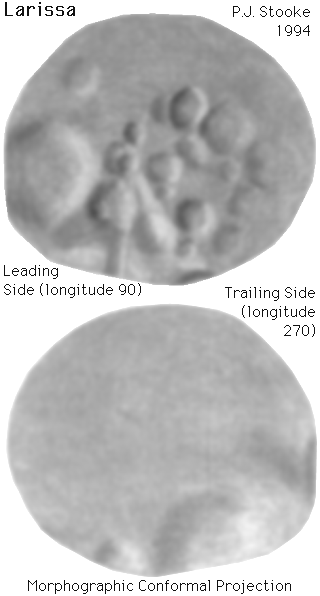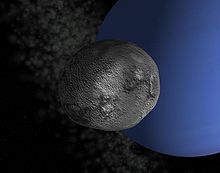.gif)
Larissa (moon)
Encyclopedia
- For the Greek city and other uses see Larissa (disambiguation)Larissa (disambiguation)-Localities:* Larissa, an important city in Greece.** Larissa Prefecture, an administrative division of Greece, centered on the city of Larissa**AEL 1964, a football club from Larissa*Larissa , the acropolis of Argos in Greece...
Larissa (icon ; Greek: Λάρισα), also known as Neptune VII, is the fifth-closest inner satellite
Inner satellite
In astronomy, an inner moon is a natural satellite following a prograde, low inclination orbit inwards of the large satellites of the parent planet. They are generally thought to have been formed in situ at the same time as the coalescence of the original planet...
of Neptune
Neptune
Neptune is the eighth and farthest planet from the Sun in the Solar System. Named for the Roman god of the sea, it is the fourth-largest planet by diameter and the third largest by mass. Neptune is 17 times the mass of Earth and is slightly more massive than its near-twin Uranus, which is 15 times...
. It is named after Larissa
Larissa (mythology)
In Greek mythology, Larissa was a local nymph from Thessaly. She was described by Pausanias as a daughter of Pelasgus. However, Hellanicus states that the sons of Poseidon and Larissa were Achaios, Phthios, and Pelasgus...
, a lover of Poseidon
Poseidon
Poseidon was the god of the sea, and, as "Earth-Shaker," of the earthquakes in Greek mythology. The name of the sea-god Nethuns in Etruscan was adopted in Latin for Neptune in Roman mythology: both were sea gods analogous to Poseidon...
(Neptune
Poseidon
Poseidon was the god of the sea, and, as "Earth-Shaker," of the earthquakes in Greek mythology. The name of the sea-god Nethuns in Etruscan was adopted in Latin for Neptune in Roman mythology: both were sea gods analogous to Poseidon...
) in Greek mythology
Greek mythology
Greek mythology is the body of myths and legends belonging to the ancient Greeks, concerning their gods and heroes, the nature of the world, and the origins and significance of their own cult and ritual practices. They were a part of religion in ancient Greece...
and eponymous nymph of the city
Larissa
Larissa is the capital and biggest city of the Thessaly region of Greece and capital of the Larissa regional unit. It is a principal agricultural centre and a national transportation hub, linked by road and rail with the port of Volos, the city of Thessaloniki and Athens...
in Thessaly
Thessaly
Thessaly is a traditional geographical region and an administrative region of Greece, comprising most of the ancient region of the same name. Before the Greek Dark Ages, Thessaly was known as Aeolia, and appears thus in Homer's Odyssey....
.
Discovery
It was first discovered by Harold J. Reitsema, William B. Hubbard, Larry A. Lebofsky and David J. TholenDavid J. Tholen
David James Tholen is an American astronomer at the Institute for Astronomy of the University of Hawaii, who specializes in planetary and solar system astronomy.-Professional life:...
, based on fortuitous ground-based stellar occultation observations on May 24, 1981, given the temporary designation S/1981 N 1 and announced on 29 May 1981. The moon was recovered and confirmed to be the only object in its orbit during the Voyager 2
Voyager 2
The Voyager 2 spacecraft is a 722-kilogram space probe launched by NASA on August 20, 1977 to study the outer Solar System and eventually interstellar space...
flyby in 1989 after which it received the additional designation S/1989 N 2 on August 2, 1989. The announcement by Stephen P. Synnott
Stephen P. Synnott
Stephen P. Synnott is an American astronomer Voyager scientist who discovered several moons of Jupiter, Saturn, Uranus, and Neptune.He discovered Metis, Puck, Larissa , Proteus, and Thebe.-References:...
spoke of “10 frames taken over 5 days”, which gives a recovery date sometime before July 28. The name was given on 16 September 1991.
Characteristics


Impact crater
In the broadest sense, the term impact crater can be applied to any depression, natural or manmade, resulting from the high velocity impact of a projectile with a larger body...
, with no sign of any geological modification. Little else is known about it. It is likely that Larissa, like the other satellites inward of Triton
Triton (moon)
Triton is the largest moon of the planet Neptune, discovered on October 10, 1846, by English astronomer William Lassell. It is the only large moon in the Solar System with a retrograde orbit, which is an orbit in the opposite direction to its planet's rotation. At 2,700 km in diameter, it is...
, is a rubble pile
Rubble pile
In astronomy, rubble pile is the informal name for an object that is not a monolith, consisting instead of numerous pieces of rock that have coalesced under the influence of gravity...
re-accreted from fragments of Neptune's original satellites, which were smashed up by perturbations from Triton soon after that moon's capture into a very eccentric initial orbit.
Larissa's orbit is circular but not perfect and lies below Neptune's synchronous orbit
Synchronous orbit
A synchronous orbit is an orbit in which an orbiting body has a period equal to the average rotational period of the body being orbited , and in the same direction of rotation as that body.-Properties:...
radius, so it is slowly spiralling inward due to tidal deceleration and may eventually impact Neptune's atmosphere, or break up into a planetary ring
Planetary ring
A planetary ring is a ring of cosmic dust and other small particles orbiting around a planet in a flat disc-shaped region.The most notable planetary rings known in Earth's solar system are those around Saturn, but the other three gas giants of the solar system possess ring systems of their...
upon passing its Roche limit
Roche limit
The Roche limit , sometimes referred to as the Roche radius, is the distance within which a celestial body, held together only by its own gravity, will disintegrate due to a second celestial body's tidal forces exceeding the first body's gravitational self-attraction...
due to tidal stretching.
External links
- Larissa Profile by NASA's Solar System Exploration
- Neptune's Known Satellites (by Scott S. SheppardScott S. SheppardScott S. Sheppard is an astronomer in the Department of Terrestrial Magnetism at the Carnegie Institution for Science. Starting as a graduate student at the Institute for Astronomy at the University of Hawaii, he was credited with the discovery of many small moons of Jupiter, Saturn, Uranus, and...
)

